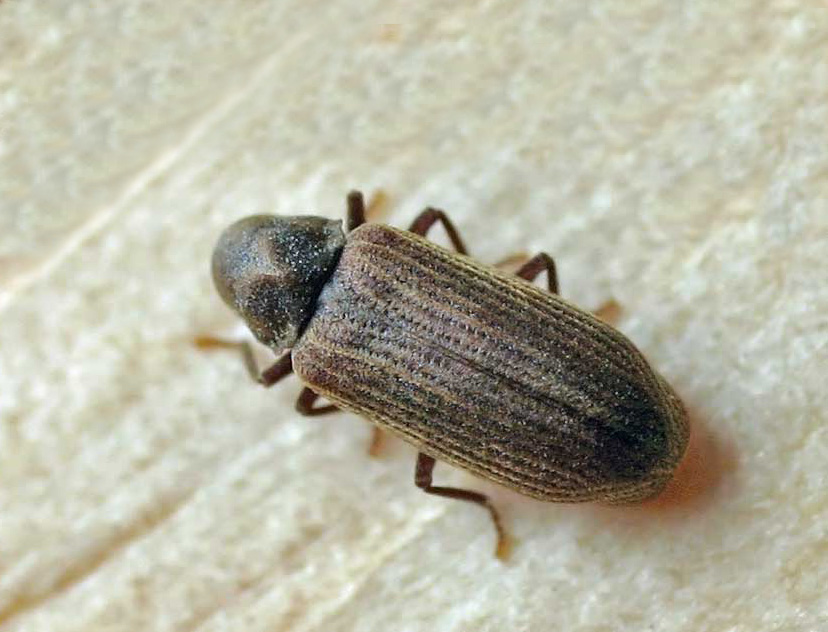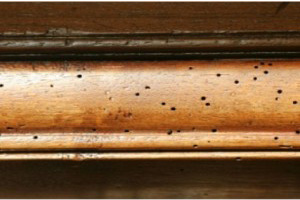One of the most annoying problems for the framer is the woodworm, which is sometimes found in the mouldings and frames. The article explains what the woodworm is and advises what to do when we find it.
Woodworms (Anobium punctatum) live from a few days to 2-3 weeks. During their short life they mate. Each female deposits about 40-60 eggs inside the wood through small cracks or irregularities of the surface.
From this observation, it follows that all the polished and well protected parts of our furniture and frames are not an environment conducive to the diffusion of woodworm.
As for the frames it is more likely that the eggs are laid on the back of it which is generally not protected by paint. Furthermore, it is much easier for woodworms to enter into the mouldings than into the finished frames. Unfortunately, the larva of the woodworm can start to eat the wood when the moulding has already been cut and assembled to form a frame. The framer, therefore, in these cases, is not able to detect the presence of the larva in the frame.
Wood is made of organic substances, vitamins, proteins, water, all that is needed for woodworms to live and reproduce. Woodwarms like soft wood such as ayous. Do not like hardwood like ramin and do not like resinous wood such as pine and fir.
Once the larvae enter the wood, they live nourishing and digging long tunnels that normally follow the veins of the wood. It is during this period that they cause the greatest damage. The galleries they create in the wood have a diameter of 2-3 mm.
At the end of the growth period the larva becomes "adult". Its color, which was initially whitish, becomes dark, almost black. At this point the adult woodworm leaves the wood through a characteristic "flickering hole".
The period between the hatching of eggs and the flicker of the adult varies depending on the species and the prevailing environmental conditions. It can last from a few months to 2-3 years. As long as the woodworm has not completed the biological cycle the attack is not visible externally.

The woodwarm (Anobium punctatum)
Woodworms are now more common now than in the past, as the climate in our apartments is now more favorable due to the presence of heating in winter.
Other factors contributing to their growth are humidity and darkness.
The life cycle of woodworms also lasts several years. At the end (usually in spring and autumn), the adult insect leaves the outside. It follows that the hole that we see, contrary to what is normally believed, is the exit hole and not the entry hole. Therefore, when we see the small holes, the damage inside is already done.

Normally the woodworms come out in the open when the heat starts, from May until July.
The presence of woodworm is noticed by small heaps of dust that suddenly appear on the floor or inside the frame. The exit holes of the worms are very evident: the recent ones have a clear colour. If we see holes with a dark colour it means that are old and that woodworms are already gone.
The framer notices the problems especially when he sees the pile of dust on the floor. In this case, he must open the moulding package from where the dust comes from. You must carefully examine all the mouldings in the package to see if they contain the classic woodworm holes. If the holes are dark it means that the woodworms have already been out for a long time and then those holes are harmless.
You do not have to completely eliminate the moulding, just take out the part that contains the tunnels. Mouldings are expensive and it is therefore not convenient to eliminate the good parts of them.
To find the bad part of the moulding the framer must gradually cut off the moulding until the "gallery" of the worm is seen.
The part of the moulding without tunnels is healthy and therefore can be used.
Instead, the defective pieces of the moulding must be taken out of the workshop and put in a garbage can to prevent the woodworms still alive to look for more wood to eat.
This is one of the most embarrassing situations for the framer job.
If the frame has been made recently (less than a year) I think that the framer should replace the frame.
If the frame has been made for more than 4 years, the worm has entered the frames when it was already in the customer's home since the maximum development time of the larva is about 4 years and then the framer can certainly give this explanation to the customer. If the frame was made in the intermediate time from 1 to 4 years, the framer could not be responsible. In these cases the framer's attitude depends on his sensitivity, on the importance of the customer, on the kindness towards the customer.
We can explain to the customer that the worms can manifest themselves even after many years. In fact, the worms may have migrated from another piece of furniture in the customer's home. We must also point out to the customer that our responsibility has a time limit. We could tell the customer that, even if we can not legally hold ourselves accountable, in order to safeguard the image of the store, we respond to it and are willing to replace the frame. We take advantage to propose a different frame and we kindly ask for a contribution equal to half of the damage or we charge the new frame by giving a big discount.
Whether the woodworm was found by the framer's customer, and if the woodworm was found in the framers store, the supplier of the moulding, within the limits of the law, is generally responsible.
It is not only responsible if the moulding was sold to us a long time ago (over 4 years).
The supplier's responsibility is particularly clear if he had told us that the moulding had been treated against woodworms.
In other cases his responsibility is more dubious.
Do or do not make a complaint? It mainly depends on the usual relationships with the supplier. It is certainly not worth making a formal complaint for a single moulding. In these cases, however, it is still advisable to inform the supplier that some of his moulding have been affected by woodwarms.
If the problem of woodworms with the supplier is too frequently, it means that the supplier uses wood that is not of first choice and therefore it is preferable to change supplier.